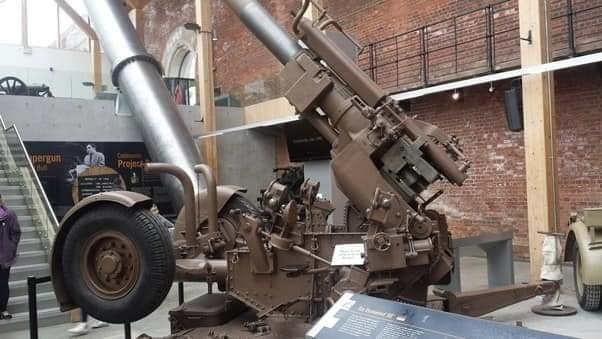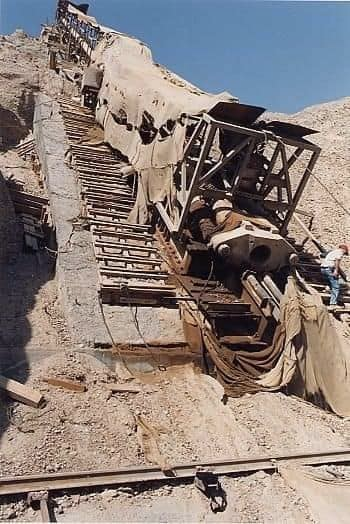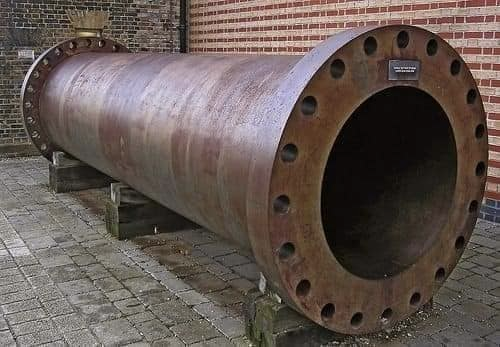Supergon of Babylon
In the early stages of the war with Iran, the Iraqi government hired world-renowned artillery expert Gerald V. Associated with Bull. His entire life was devoted to building a "super gun" that would be able to shoot satellites into space or launch artillery shells thousands of miles. Although he did not achieve that dream of firing into enemy territory, some of the world's most talked-about pieces of artillery Bull managed to create.

Bull, a Canadian astrophysicist, previously held research contracts with the US military, the Canadian Department of Defense and McGill University. While working on the Canadian Velvet bulletproof clothing project, developing scientific instruments, he realized that he could survive being shot by a gun if properly covered. Bull received US military support in 1962 for the US/Canadian High Altitude Research Program [HARP]. Initially operating from a position on the island of Barbados, a small 5-inch gun was used to fire projectiles at altitudes of over 70 km, while the 7-inch guns fired projectiles at nearly 100 km. Later, Arizona forged a large HARP gun by welding a pair of 16-inch battleship guns together to form a barrel about 30 meters long. This gun was used to fire lightweight Khyber-disrupting projectiles called Martlets. On November 19, 1966, the gun fired a 185-pound martlet at an altitude of 180 km. The 16-inch HARP gun was intended to launch a small three-stage rocket with a payload of 10 kg into space. However, the Canadian and US governments canceled HARP funding in 1967.
Bull broke ties with the Pentagon in the 1970s and contracted companies to sell improved versions of the technology he developed to a number of foreign governments, including Iran, Chile, Taiwan and China. Working through his own Quebec company, the Space Research Corporation, and a Belgian subsidiary, the European Poderies Reunions de Belgique, Bull was able to develop his most powerful battlefield artillery piece, the GC-45 gun. Twice the weight of guns used by western armies. He was sentenced to a year in prison for illegally selling arms to South Africa in 1980 despite a US arms embargo.
Shortly after the start of the Iran-Iraq war, the Iraqi government sent a private plane to Geneva to take Bull to Baghdad. A long relationship began between Bull and the Iraqi government and its then defense minister, Saddam Hussein. Bull dealt with Iraq for almost 10 years. Iraq is one of the many states with guns developed by Bull. His clients include his native Canada, the United States, South Africa, Iran, Chile, Taiwan, China and Libya.
From mid-1981 until his assassination on March 22, 1990, the main concern in Iraq's gun arsenal were 300 300 mm 155 howitzers and all versions of the GC-45 gun designed by Bull in the 1970s. Two hundred of these guns, known as the GH-N-45, were manufactured in Austria and shipped to Iraq via Jordan in 1985 for use in the Iran-Iraq War. The remaining 100 were produced in South Africa and marketed as the G-5. The G-5 can deliver a tactical nuclear warhead, chemical shells or any NATO standard 155mm shell.
Bull also designed two advanced automatic artillery systems for the Iraqis: the 210 mm Al Fawo and the 155 mm Majnoon. Weighing 48 tons, the Al Favo could fire four rounds of 109 kg per minute for 35 miles from an 11-meter barrel. The Iraqis claim a top speed of 72-88 km/h on Al Fawo and Majnoon roads.
Bull modified missile warheads, which increased the range of Iraq's Scud missiles, are also a concern.
Under Project Babylon, Bull extended his HARP gun design to build barrels in sections 512 feet long. The gun can fire a 600 kg projectile to a range of 1,000 km or a 2,000 kg rocket-assisted projectile into orbit.
As part of Project Babylon, Bull built a small gun, nicknamed Baby Babylon, as a prototype for the big gun. The 40-meter-long gun was first built for horizontal testing in the summer of 1989 and installed at Jabal Hamreen, ninety miles north of Baghdad in central Iraq [Jabal Hamreen MTS 34°30'N 44°30'E]. The gun is positioned on a hill with an elevation of about 45 degrees.

In documents filed with the United Nations Special Commission on July 18, 1991, Iraq admitted that it had a gun with a barrel 350 mm wide and 45 meters long and that it was building a second one. The commission noted that the gun would be inaccurate for conventional weapons and was trying to determine whether the weapon was for chemical, biological or nuclear use. Chemical, biological and nuclear weapons to super guns 1,0 km

#krsuccess #geekpranee #supergun #earth #babylonian #scientists #story
Downvoting a post can decrease pending rewards and make it less visible. Common reasons:
Submit